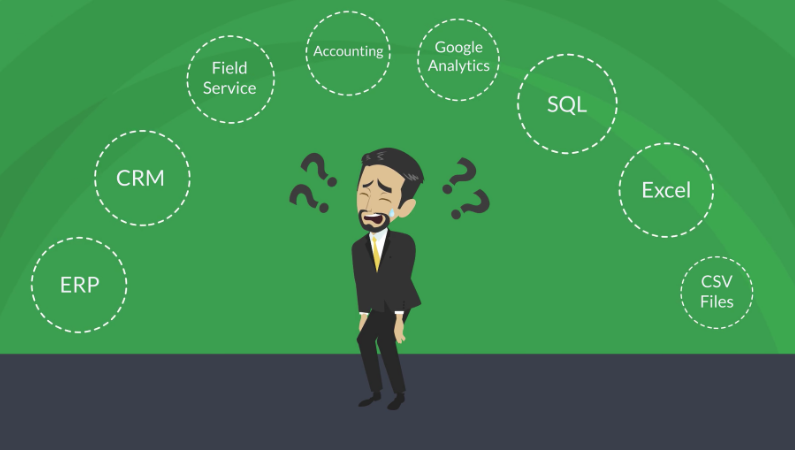Common Data Challenges

Top companies frequently share a number of positive management characteristics, but they also suffer many common challenges as they make the transition to becoming data-driven businesses. These include:
Siloed Data
Businesses today run on a collection of on-premise and cloud-based applications, e.g. accounting, sales and marketing, CRM, ERP, field service, point-of-sales, spreadsheets, databases, data warehouses, etc.
Oftentimes these systems are isolated from one another and cannot easily aggregate and share data—making it very difficult to get a comprehensive view of an organization.
Missing or Incomplete Data
Frequently, out-of-the-box software deployments are not set up for the unique requirements of a business. Or, if they were initially configured correctly, the company’s needs have changed over time and the solution hasn’t been adapted along the way. This can result in missing, incomplete, or improperly formatted data that makes accurate analysis very challenging—if not impossible.
Static Reports
Today’s Line-of-Business (LOB) software solutions are excellent at their core functionality but many lack comprehensive analytics. These systems generally produce static, text or table-based reports that do not allow for interaction, drill-down, or root-cause analysis.
Slow, Manual, and Error-Prone Data Prep
To compensate for the limitations noted above, users are frequently forced to manually export tabular data, merge Excel files, cobble together charts and graphs, paste them into PowerPoint slides and then email the completed report to stakeholders across the organization.
This, in turn, spawns a litany of questions, uninformed comments, requests for changes, additions, and updates that inevitably result in errors, wasted time, and delayed action.
To make matters worse, those responsible for managing this data—particularly at small and midsized firms—are often highly-paid controllers, sales VPs, operations directors, customer service managers or even c-level executives preparing quarterly Board reports.
This process results in a significant financial burden and constrains leaders from focusing on the actual data analysis and decision-making that drives performance.
Uncontrolled Data Access
Manual, multi-step data preparation and file-sharing can leave an organization vulnerable to data breaches and unauthorized internal access to sensitive information. Highly valued data such as lead lists and customer databases could be exported and taken by employees exiting the company. An unlocked Excel tab could expose company-wide salary figures or sales quota information to the wrong recipients.
Limited Communication and Collaboration
While companies struggle to secure data being exposed by manual processes, they also find it difficult to manage and encourage effective communication using the data that is accessible.
Each department may be using a unique collection of tools, processes, calculations, and nomenclature that make it difficult to synthesize data and convert it to actionable information.
To compound matters, these teams lack a standardized way to disseminate and collaborate on the analysis once it has finally been completed.
The Consequences
These common data challenges—along with an endless array of company-specific issues—frequently result in businesses that operate from a reactive, damage-control posture.
Teams are busy putting out fires and trying to “get to the bottom of things” rather than working from a proactive, forward-looking position that allows them to make informed decisions that will increase profitability and long-term growth.
Here at PIVOTL, we’re on a mission to bring the financial benefits and competitive advantage of enterprise-level analytics to small and midsize organizations across the Southland. If you would like assistance planning, developing, and implementing Microsoft Power BI at your company or non-profit, we encourage you to reach out for a free, no-pressure consultation.